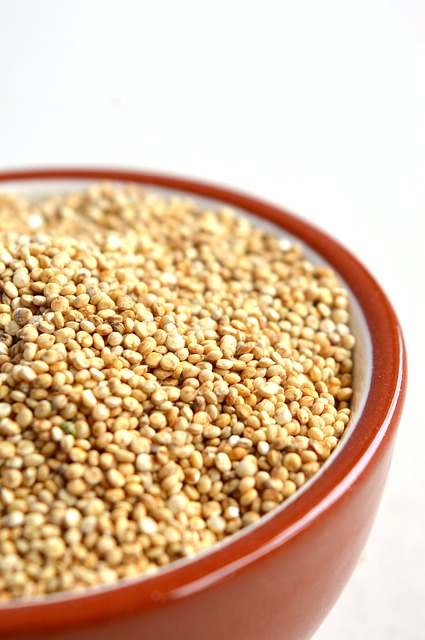PROTEIN2FOOD works with some of the most promising future food crops that have the potential to help Europe transition to more sustainable proteins.
Quinoa (Chenopodium quinoa)
-

Quinoa
Quinoa belongs to the Chenopodiacea family and is botanically related to sugar beets, spinach and ribs. Native to the Andean region of South America (Peru, Bolivia, Ecuador, Chile), quinoa has been cultivated for thousands of years and gained extraordinary status as the Mother of all grains “chisiya mama” by ancient Incas. Since 2009, this pseudo-cereal has experienced exponential increases in imports to Europe, as well as production in France, Spain, Denmark and the Netherlands. The crop is sown in early April and harvested in August. PROTEIN2FOOD research has shown that Titicaca and Vikinga varieties have shown the most promise in European countries such as Italy, while research in Denmark has focused on decreasing the saponin content, increasing the grain size and increasing the yield among other things.
This powerhouse of a seed is rich in high quality proteins, containing the essential amino acids; lysine and methionine. Because of this, it contains all nine essential amino acids and is considered a complete protein, which is often not the case with other cereals. It also has a good balance of carbohydrates and fat, a source of Fe (iron), classified as a whole grain and naturally gluten and allergen free.
This plant is extremely hardy and adaptable, tolerating frost, droughts, salinity, high winds and needing little fertilisation, which means it can grow in diverse climates and terrains, an important aspect for future food security. The saponins from quinoa can be used in side-streams for products like cosmetics and soaps.
Quinoa has a host of different uses, it can be eaten as a hot breakfast porridge, as a rice replacement, sprouted or popped like popcorn, ground and used as flour for biscuits, breads, processed foods, as well as used in malted drink formulations. The PROTEIN2FOOD project has currently developed a number of quinoa-based food prototypes among them include; milk substitutes, gluten free bread and meat alternatives.
[1] The Nutrition Source. (n.d.) Quinoa. Harvard T.H Chan, School of Public Health. [Accessed 9 September 2019]. Accessed from: https://www.hsph.harvard.edu/nutritionsource/food-features/quinoa/
[2] Arendt, E.K. & Zannini, E. (2013). Cereal grains for the food and beverage industries, Chapter 12 – Quinoa [online]. Oxford: Woodhead Publishing Limited. [Accessed 9 September 2019] Available from: Google Books.
Lupin (Lupinus spp.)
-
Blue Lupin
Lupin (Lupinus L.) is a flowering plant cultivated as a food and as ornamental plant. The edible seeds are technically part of the legume family, sharing similar traits with chickpeas, soybeans, lentils and peas. The four most cultivated lupin species are the blue narrow leaf lupin (L. angustifolius), white broad leaf lupin (L. albus) and the yellow lupin (L. luteus). PROTEIN2FOOD cultivates the blue, white and Andean lupin (L. mutabilis).
Lupins were cultivated in ancient Greece and Egypt before 2000 BC for consumption, medical and cosmetic purposes. These seeds pack a high amount of protein, containing between 30-40% depending on the species, while providing a good source of dietary fibre. The digestibility of lupin protein is comparable to milk, soy, pea and wheat proteins.
The blue narrow leaf, white broad leaf and yellow lupin comprise the category of sweet lupins and are annual crops. They are highly resistant crops and can grow in poor soils and under extreme conditions, however they are susceptible to mold and high moisture levels. As they are part of the legume family, lupins can also fix nitrogen (150-200 kg N/ha) from the air, into the soil and are able to mobilise soil bound phosphate. This means that potassium is the only fertiliser needed and there is no dependency on fossil energy-dependent manufacturing of nitrogenous fertilisers. These are all factors that influence lupin’s perfect spot as a future food crop for a sustainable food system.
Although the majority of lupin is still consumed by animals, consumers are starting to wake up to their benefits, with current food products like ice cream, pasta, milk replacements and breads, based on various lupin ingredients like protein isolates, concentrates and flours.
For more information about lupins and their role in PROTEIN2FOOD watch the interview with PROTEIN2FOOD researcher, Udo Prins from Louis Bolk Institute.
[1] Lupins.org. (n.d.) Global Production & Trade. [Accessed 9 September 2019]. Accessed from: http://www.lupins.org/lupins/#production.
[2] van de Noort, M. (2017). Sustainable Protein Sources. Chapter 10 – Lupin: An Important Protein and Nutrient Source. [online]. Academic Press. [Accessed 9 September 2019] Available from: https://www.sciencedirect.com/science/article/pii/B978012802778300010X.

